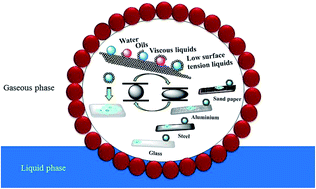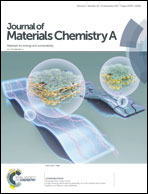pH-responsive superomniphobic nanoparticles as versatile candidates for encapsulating adhesive liquid marbles†
Abstract
Conventional adhesives are rarely used in sophisticated applications such as micro-fluidic devices or ‘operations of bonding from a distance’ due to their permanent wetting characteristics. Liquid marbles offer exceptional switching between non-wetting and wetting on demand. In this contribution, we present a novel approach to encapsulate both hydrophilic (epoxy resin) and hydrophobic (siloxane polymer) liquids via wrapping them with superomniphobic nanoparticles. The free energy for marble formation is lower for a hydrophobic liquid (0.931 × 10−16 J), whereas a hydrophilic liquid registers a higher value of 1.86 × 10−16 J. The mechanical bursting energy for hydrophobic marbles (20 μJ) is lower than that for their hydrophilic counterpart (48.6 μJ). The static friction coefficients of epoxy-based liquid marble are between 0.015 and 0.020 on glass, aluminium and stainless steel substrates. As a highlight, the nanoparticle coating is responsive to pH, and the bursting time of the liquid marbles can be tuned from <1 minute to several hours. It is demonstrated that the adhesive strength of cross-linked epoxy obtained by a liquid marble route is higher than that obtained vis-a-vis a conventional wetting route. The liquid marbles presented in this work can be ruptured by changing the pH, have a lower friction coefficient compared to the bare liquids (more rolling distance, which is highly essential for bonding of an intricate space from a distance) and are useful as dry adhesives.



 Please wait while we load your content...
Please wait while we load your content...